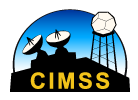On 12 June 2017 two pyroCbs formed northwest of Lake Baikal in eastern Russia. Himawari-8 detected these smoke plumes and pyroCbs cloud, as well as the fires hot spots. The first pyroCb cloud (~54.3º N, 105.7ºE) formed around 9:20 UTC . The second pyroCb cloud (~55.4º N, 107.4ºE) formed around 10:50 UTC. Starting at 9:00 UTC on 12 June, the animation below shows Himawari-8 0.63 µm visible (left) and 3.9 µm shortwave IR (right) . In the shortwave IR images, the red pixels indicate very hot IR brightness temperatures exhibited by the fire source regions.

HIMAWARI-8 0.63 µm visible channel (left) and 3.9 µm shortwave IR channel images (right) (click to play animation)
In addition, using Himawari-8 10.4 μm IR channel the cloud-top IR brightness temperature could be found. The animation below, starting at 10:30 UTC on 12 June, shows the brightness temperature for the first pyroCb cloud reaching near -60ºC. The image below indicates the minimum brightness temperature to be -60.2ºC at 13:48 UTC. This is far later than the loop. The second pyroCb reaches a minimum brightness temperature at 11:02 UTC (green color enhancement).
A 1-km resolution NOAA-19 AVHRR 10.8 µm Infrared Window image (below;courtesy of René Servranckx) revealed a minimum cloud-top IR brightness temperature of -60.2º C (red color enhancement) for the first pyroCb and -44.9º C for the second (green color enhancement) .
![NOAA-19 AVHRR 0.64 µm visible (top left), 3.7 µm shortwave IR (top right), 10.8 µm IR window (bottom left) and false-color RGB composite image (bottom right) [click to enlarge]](http://pyrocb.ssec.wisc.edu/wp-content/uploads/2017/06/thumbnail_20170612_1102UTC_N18_GAC_ch1_ch3_ch4_ch321.jpg)
NOAA-19 AVHRR 0.64 µm visible (top left), 3.7 µm shortwave IR (top right), 10.8 µm IR window (bottom left) and false-color RGB composite image (bottom right)


![Himawari-8 0.64 µm Visible (top), 3.9 µm Shortwave Infrared (middle) and 10.4 µm Longwave Infrared Window (bottom) images [click to play animation]](http://pyrocb.ssec.wisc.edu/wp-content/uploads/2017/05/170525_himawari8_visible_shortwaveInfrared_infraredWindow_Lake_Baikaal_anim-1024x770.gif)


![Suomi NPP VIIRS and Aqua MODIS true-color images [click to enlarge]](http://pyrocb.ssec.wisc.edu/wp-content/uploads/2017/02/170212_suomi_npp_viirs_aqua_modis_truecolor_NSW_Australia_wildfires_anim.gif)

![Himawari-8 Visible (top), Shortwave Infrared (middle) and Infrared Window (bottom) images [click to play animation]](http://pyrocb.ssec.wisc.edu/wp-content/uploads/2016/12/161206-07_himawari8_visible_swir_ir_Cockebiddddy_Fire_AUS_anim-1-1024x770.gif)








